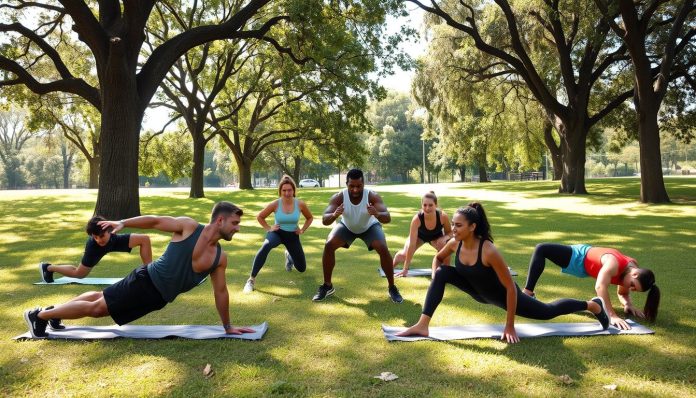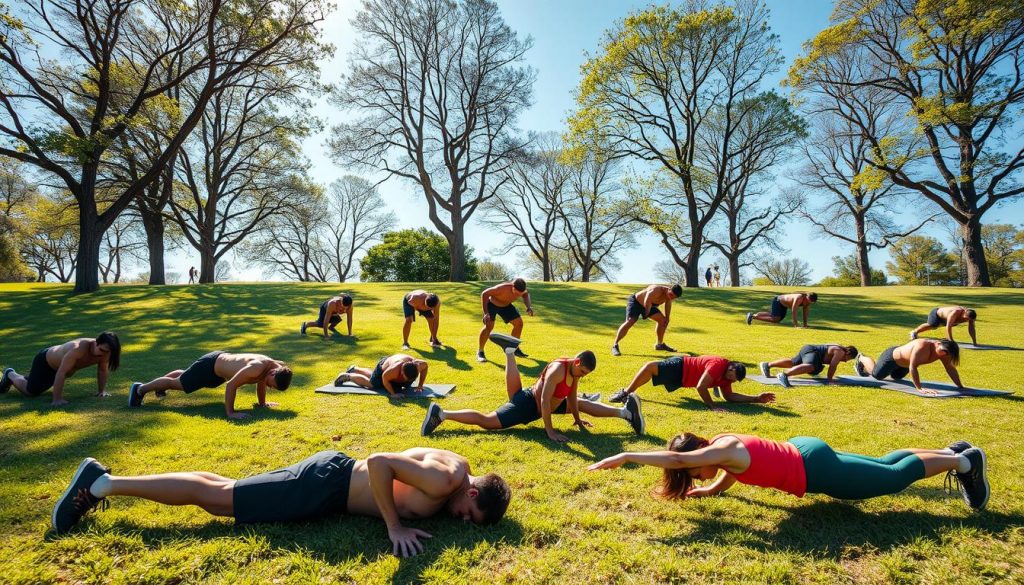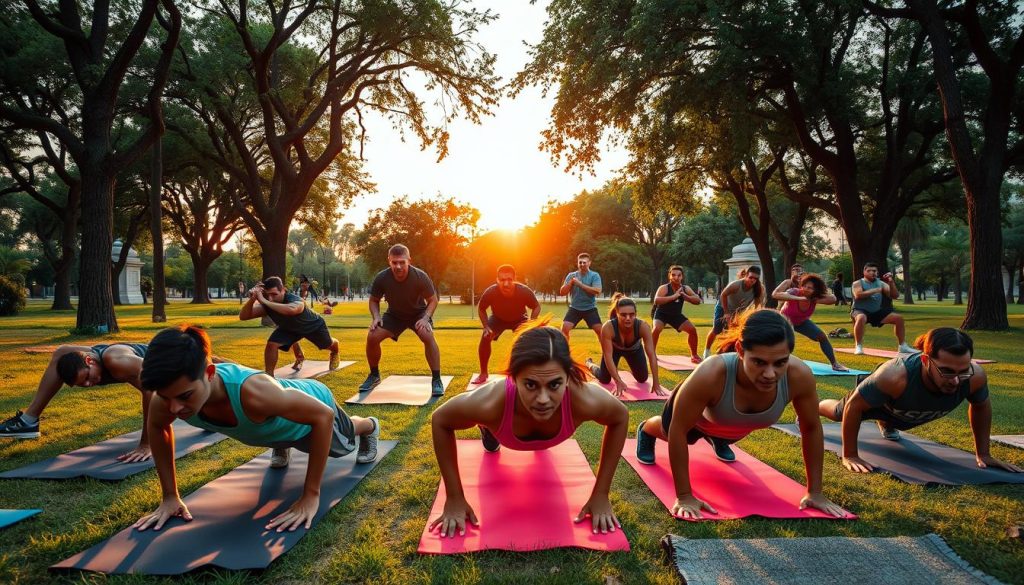You can get a full-body workout with just your bodyweight. It’s simpler than you might think. Bodyweight exercises are perfect for beginners. They help you learn the right form and movement.
These exercises can make you stronger, more flexible, and fitter. You can do them all from home. This makes working out at home easy and effective.
Doing push-ups, squats, and lunges can raise your heart rate. They mix cardio with muscle building. Adding bodyweight exercises to your routine can prevent muscle imbalances and injuries.
To start, you don’t need any special equipment. Just a chair, table, or step, and an exercise mat are enough.
Key Takeaways
- You can get a total-body workout with just your bodyweight, making at-home workouts a great option.
- Bodyweight exercises can help build strength, increase flexibility, and improve overall fitness.
- Engaging in bodyweight exercises can reduce the risk of muscle imbalances and chronic injuries.
- You don’t need any equipment to get started with bodyweight exercises, just a few basic items like a chair or exercise mat.
- Bodyweight exercises can be modified to accommodate varying levels of difficulty, making them accessible to everyone.
- Incorporating bodyweight exercises into your routine can help you achieve a total-body workout and improve your overall health.
Understanding Total-Body Workouts
Many think they need expensive gym gear to get fit. But, you can work out great with just your body. Bodyweight training boosts strength, flexibility, and heart health. It’s ideal for those who like no equipment workouts.
Total-body workouts mix exercises for different muscles, like push-ups and squats. They can be adjusted for all fitness levels. Start simple and increase the challenge as you get better. Focus on doing the exercises right, not how heavy you lift.
Bodyweight training is flexible and can be done anywhere. You can work out at home, in the park, or on the go. This flexibility, along with its benefits, makes it a great choice for those on a budget or with busy lives.
Adding bodyweight exercises to your routine can greatly improve your health. It offers many benefits without needing expensive equipment. So, why not try it? With some creativity and effort, you can reach your fitness goals and enjoy the perks of no equipment workouts for years.
Getting Started with Bodyweight Exercises
Starting with bodyweight exercises is exciting. First, check your current fitness level and set goals. This makes your workout plan fit you perfectly. Plus, you can do these exercises at home, which is easy and convenient.
When planning your workout, remember to focus on form and technique. Good form prevents injuries and makes your workouts more effective. Focus on slow and controlled movements. Start with simple exercises like push-ups and squats, and get harder as you get better.
Your workout should mix upper and lower body exercises and core movements. Do 2-4 workouts a week, resting for 48 hours between. This lets your muscles recover and grow stronger. Following these tips will help you reach your fitness goals and enjoy working out at home.
Assessing Your Fitness Level
Before starting, evaluate your fitness level. This helps you see where you need to improve. Look at your strength, flexibility, and endurance. Use this info to set goals and track your progress.
Essential Bodyweight Exercises to Include
Creating a good bodyweight workout routine means picking exercises that work many muscles at once. The best exercises are those that target several areas of the body. This way, you get a full workout. Bodyweight training is great for boosting fitness, and a solid routine can help you reach your fitness goals.
Push-ups, squats, and planks are top choices for bodyweight exercises. They help build strength and endurance. Plus, you can adjust them to fit your fitness level. For example, you can do push-ups on knees instead of toes for an easier version. Squats can be made harder by pausing at the bottom.
Adding these exercises to your routine can boost your fitness. Start slow and gradually make the exercises harder as you get better. With regular practice and commitment, you can craft a balanced bodyweight workout that meets your needs.
Push-Ups: Strengthening Your Upper Body
Push-ups are a classic exercise that work the chest, shoulders, and triceps. Begin in a plank position with hands shoulder-width apart and feet hip-width apart. Lower your body until your chest almost touches the ground, then push back up.
Squats: Building Lower Body Power
Squats are excellent for strengthening the lower body. Stand with feet shoulder-width apart and hands by your sides. Lower your body into a squat, keeping your back straight and knees behind your toes. Push back up and repeat.
Plank: Core Stability and Endurance
Planks are great for building core strength and endurance. Start in a plank position with hands shoulder-width apart and feet hip-width apart. Hold the position for at least 30 seconds, engaging your core muscles.
Structuring Your Bodyweight Workout Routine
Creating a bodyweight workout routine is key to reaching your fitness goals. It’s great for improving fitness, strength, or heart health. You can do it anywhere, anytime, without any equipment.
Start by checking your fitness level and setting achievable goals. Mix exercises like push-ups, squats, and lunges to work different muscles. Don’t forget core exercises like planks and Russian twists for better stability and strength. Gradually increase the difficulty to avoid getting stuck.
Warm-Up Essentials
A good warm-up is vital before any workout. It prevents injuries, boosts flexibility, and gets your muscles ready. Begin with light cardio like jogging or jumping jacks. Then, stretch to loosen up your muscles.
Designing a Balanced Routine
A balanced routine should cover various muscle groups. Start with simple exercises like push-ups, squats, and lunges. As you get stronger, move on to harder ones. Include core exercises and stretching to enhance fitness and flexibility. Always listen to your body and rest when needed to avoid injury.
Modifying Exercises for Different Fitness Levels
It’s key to adjust bodyweight exercises based on your fitness level. This way, you challenge yourself but avoid injury. Beginners should start with easier versions of exercises like push-ups, squats, and lunges. Then, increase the difficulty as you get stronger.
For example, try push-ups on your knees instead of toes for beginners. This makes it easier to start. As you get stronger, move to traditional push-ups and then try diamond or decline push-ups.
At-home workouts are great for bodyweight exercises. They’re easy to do anywhere, anytime, and need little equipment. This makes it simple to keep up with your workouts and see progress. By adjusting exercises to fit your level, you can make a good at-home workout plan.
Scaling Movements for Beginners
Scaling movements means finding a version of an exercise that’s just right for you. For newbies, start with bodyweight squats and add weight or depth as you get stronger. This builds a solid base and lowers injury risk.
Advanced Variations for Experienced Users
When you’ve got the basics down, try more challenging versions of exercises. You can add weight, do more reps, or change how fast you move. For example, try explosive push-ups or slow squats to work your muscles differently. Adding these advanced moves keeps you progressing and prevents getting stuck.
Incorporating Cardio Into Your Bodyweight Workout
Adding cardio to your bodyweight workout is key for a balanced fitness plan. Bodyweight exercises can boost your heart health. You can get a great workout without any equipment.
Try High-Intensity Interval Training (HIIT) or circuits to add cardio. HIIT has short, intense exercises followed by rest. Circuits are quick, back-to-back exercises. You can start with burpees, jump squats, or mountain climbers to raise your heart rate and work your muscles.
Benefits of HIIT and Circuits
HIIT and circuits are great for your heart, burn calories, and build muscle endurance. They make your bodyweight workouts more effective. Always listen to your body and adjust your workout as needed.
Overcoming Workout Plateaus
When you keep doing bodyweight workouts, you might hit a plateau. It feels like you’re not getting better, even when you try hard. But remember, a plateau doesn’t mean you’re not improving. You might be getting better at form or lasting longer, even if you don’t see big number changes.
To get past a plateau, try new things and challenge yourself. Use bodyweight training methods like progressive overload or drop sets. Also, don’t forget to rest well. Not resting enough can make you overtrain and perform worse.
Changing how hard, long, and often you work out can really help. Make sure to drink lots of water, too. Aim for 2-3 liters a day, more if you’re working out hard. By doing these things, you can keep improving and enjoy the benefits of bodyweight workouts.
Stay consistent and patient. Use fitness trackers to see how you’re doing. Stick to your workout plan to reach your fitness goals. With the right attitude and plan, you can beat workout plateaus and keep getting better.
Tracking Your Progress
As you keep up with your bodyweight workout, tracking your progress is key. Keeping a workout journal is a great way to do this. It lets you see how far you’ve come and what you need to work on.
Bodyweight training can be harder to measure than weight training. But, you can track your progress in many ways. For instance, you can do more exercises in less time or move better in your exercises.
Watching how your body changes is another way to track progress. A smaller waist can mean you’re gaining muscle and losing fat. Tools like Dexa scans or BodPods can also show changes in your body fat every few months.
Remember, getting better at bodyweight training takes time and effort. By doing more exercises, training faster, and adjusting your stance, you can get stronger and feel less tired. With hard work and patience, you’ll see big improvements in your fitness and enjoy the benefits of bodyweight training.
Staying Motivated and Consistent
Keeping up with a bodyweight workout routine can be tough. But, staying motivated is essential to reach your fitness goals. Finding a workout buddy or joining an online community can help a lot. Sharing your progress and celebrating together makes the journey fun and keeps you going.
Setting achievable goals and celebrating your wins is also important. It gives you a sense of accomplishment and motivates you to do more. Whether it’s mastering your first push-up or doing more exercises, seeing your progress keeps you motivated.
Consistency is key to getting the most out of bodyweight training. Stay committed to your workouts and celebrate your achievements. This will help you build a stronger, more resilient body.
FAQ
What constitutes a total-body workout?
A total-body workout targets all major muscle groups. This includes your upper, lower body, and core. You can do this with just your bodyweight, using exercises like push-ups, squats, and planks.
What are the benefits of bodyweight training?
Bodyweight training boosts strength, flexibility, and fitness. It builds muscle and improves heart health. You don’t need any equipment to do it.
How do I get started with bodyweight exercises?
First, check your fitness level and set goals. Make sure you have enough space and use proper form to avoid injury. Start with simple exercises and get better as you go.
What are the essential bodyweight exercises for a total-body workout?
Key exercises include push-ups for upper body, squats for lower body, and planks for core. These exercises work many muscles and can be adjusted for different levels.
How do I structure a bodyweight workout routine?
Start with a warm-up, then do a mix of exercises. Finish with a cool-down and stretch. This prepares your body and helps recovery.
How can I modify exercises for different fitness levels?
Adjust movements for beginners or experienced users. Start with basic form, then add more challenge. This keeps workouts effective and fun.
How can I incorporate cardio into my bodyweight workout?
Use HIIT or circuit training for cardio. HIIT has intense bursts followed by rest. Circuits mix strength and endurance with little rest. Both improve heart health and fitness.
How do I overcome workout plateaus?
Recognize when progress stalls. Change exercises, increase intensity, or try new versions. Regularly check your progress to keep improving.
How do I track my progress with bodyweight exercises?
Keep a workout journal to track your exercises and results. This helps you see what works and make needed changes.
How can I stay motivated and consistent with my bodyweight workout routine?
Find a workout buddy or join a community for support. Set goals and celebrate your achievements. Vary your workouts to stay interested and engaged.




